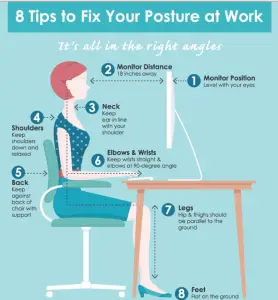We tend to expel less energy while we are sitting down than if we were to move around or stand. Studies have found that numerous negative health effects are linked to sitting down for long periods of time.From obesity, raised blood pressure, high blood sugar, extra body fat around the waist and high cholesterol levels that make up metabolic syndrome, prolonged periods of sitting increase risk of death from cardiovascular disease and cancer.

Lower back pain
Spending a lot of time sitting at a desk, behind your steering wheel, or in front of the TV can be harmful. A report of 13 studies of sitting time and activity levels found that people who sat for over 8 hours a day without physical activity had a risk of dying remarkably close to the risks caused by obesity and smoking. This analysis of data from more than a million people found that an hour and a quarter of medium intense physical activity each day counteracted the negative of too much sitting. A different study found that a longer amount of sitting time contributed only a little to mortality for people who were most active.
Further study is required on the effects of sedentary and physical activity on health. But it looks clear that less time sitting and more time moving about would certainly contribute to healthier lives. Anyone can begin by simply standing rather than sitting whenever you can or finding ways to walk around at your work place.
Take a break from sitting every 30 minutes.
Tips for improving your well-being include standing whilst you talk on the phone or watching television. If you work at a desk, switch to a standing desk or find a high table or work top. Walk alongside your colleagues for meetings instead of sitting in a conference room.
Attach your desk above a treadmill with a computer screen and keyboard on a stand or a specially built vertical desk. This allows you to be in motion throughout the day.
The impact of movement, even light movement, can be beneficial. You will use more calories, which can lead to weight loss and boost in energy. Not only that, physical activity helps keep up muscle tone, your ability to move and your mental well-being, especially in later years.

Best way to sit at a desk | courtesy : portablelaptopstands
Around the world, especially in the United States, people aren’t as active as previous generations. Research estimates that we are not physically active (sedentary) for about 7.7 hours a day (an average). On top of this, fewer than 20% of us are employed in jobs that require physical activity with more and more people spending over 50% of the working day seated. This buildup of time spent sitting can cause serious health issues even for people who aren’t usually active .
The dangers of too much sitting.
Our bodies are meant to be up and moving, whether you’re working or playing and to be seated only when resting. A sloth-like lifestyle, which may include sitting in an office for long periods of the day, getting around by sitting in a car or bus, spending time watching Television or browsing the Internet while sitting can affect our bodies in numerous ways. Examples of this can be:
- Burning less calories, which can cause weight gain.
- Lose muscle strength and have weaker bones.
- Have reduced blood circulation.
- Have a weakened immune system.
- Obesity.
- Osteoporosis.
- Stroke.
- Develop inflammation.
- Develop hormonal imbalances.
Health problems related to too much sitting
Health issues associated with a seated lifestyle and not getting regular exercise can raise your risk of:
- Early death.
- Type 2 diabetes, Heart disease, and a few types of cancer.
- Metabolic syndrome (raised blood pressure, higher blood sugar, more body fat around the waist, and abnormal cholesterol or triglyceride levels).

If you sit for long periods of time in an office working on a computer, you open yourself to be at risk for getting physical strain and overuse injuries.
Moving throughout the day can be even more beneficial than exercise to lower your risk of all these health problems.
Scientists first noticed something during a study that between two similar groups: guards or conductors, who are standing and transit drivers, who sit for long periods. Though their diets and lifestyles were very similar, those that sat doubled their risk of heart disease compared to those that did not.
If you sit for too long, your brain could resemble that of a person with dementia.
It could be that you’re often alone and looking at your screen. This can disrupt your sleep, and you can get more anxious. This also might lead to social anxiety since spending a lot of time alone can make you withdraw from loved ones. Scientists are still trying to uncover an exact cause.

Lower back pain when sitting
The American Academy of Orthopaedic Surgeons, signs and symptoms may include:
- A tingling feeling in the fingers, sore wrists, and lower back pain.
- Eye strain, as well as redness, a feeling of dry or soreness, blurred vision, and headache.
- Pain felt in the neck, thighs, shoulders, back, arms, and lower legs.
- Consistent pain or discomfort in the muscles and tendons, commonly known as repetitive strain injury.
Protect Yourself
Steps you can take to reduce your risk
Should your job require you to sit at a desk and/or spend long lengths of time working on a computer, there are steps you can take to help avoid or prevent some of the health risks.
1. Incorporate movement into your workday.
- Stand up to move around at least once each hour.
- Walk up the stairs instead of the lift whenever you can.
- When you’re in meetings, remain standing rather than sitting.
- Go for a walk outdoors whilst on your lunch and break times.
- Rather than sending emails or phoning your co-workers, walk over to speak to them.

Best sitting positions for lower back pain
A lot of students for instance are suffering from spending a lot of time at their desks during classes and at home. In order to help them save time in their writing tasks, WriteMyEssay4Me is a suitable solution. This allows them to have some extra time for physical activity and meeting with friends.
2. Use a standing desk
Studies have shown that people who use a sit/stand desk, experienced reduced upper back and neck pain and felt more energized, comfortable, productive and focused as opposed to those who didn’t have one.
3. Set up your desk properly and maintain a good posture
The computer screen should ideally be about an arm’s length away from you and the top of your monitor should be at forehead level. This will help avoid looking up or down.
The mouse and keyboard should be at a height that keeps your elbows at your side and bent at 90 degrees. This will keep you from having to stretch too far to use them.
Whilst seated, your hips and knees should be at 90-degree angles. Have your feet flat on the floor or use a foot rest.
Your head should remain directly over your shoulders. Don’t lean forward closer to your computer.

correct sitting posture | courtesy: emory orthopedic
Some people may not be able to avoid sitting at a desk or working on a computer for long periods of time. Using these tips can help you avoid some of the health risks of doing so.
If you like the content, we would appreciate your support by buying us a coffee. Thank you so much for your visit and support.
